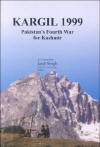|
| Home | About Kashmir Herald | |
Volume 1, No. 9 - February 2002 |
|
| The Killing Machines of JeM and LeT: Tools of Fascist Power |
|
|
|
The Killing Machines of
JeM and LeT: Tools of Fascist Power Romeet Kaul Watt The extended arms of the dreaded Al-Qaida in Pakistan are the Lashkar-e-Toiba (LeT) and Jaish-e-Mohammed (JeM). Both these ultra-fundamentalist groups have close ties with the former Taliban regime, and its downfall is a tremendous setback for them. However, Indian analysts believe that the Al-Qaeda is likely to strengthen the terrorist cadres in Pakistan by coalescing with parts of existing sub-groups and individuals. This article discusses the relation between these groups and Pakistan’s fascist goals in the subcontinent, and the likely changes Pakistan will institute to achieve these goals in the current scenario. Jaish-e-Mohammed (JeM)
and Lashkar-e-Toiba: Background The LeT is the armed wing of the Pakistan-based religious organization, Markaz-ud-Dawa-wal-Irshad (MDI)--a Sunni missionary organization formed in 1989. It is one of the three largest and best-trained groups fighting in Kashmir against India. Dawatul Irshad is a resourceful organization because of its hold on the civil society in small regional districts. His headquarters, a city within a city outside Lahore in Muridke, was built from Arab money. The power of the Lashkar also derives from its Salafi origin. It maintained connections with the Wahhabi camps in Kunur in Afghanistan and Arab warriors in Afghanistan. Its links with Osama Bin Laden have been craftily hidden although news appearing in Pakistani press has linked the two. LeT & JeM: The
Operations These groups have also been responsible for inflicting heavy causalities on Indian security personnel through fidayeen missions designed to lower morale. The spectacular attacks carried out by the groups include the October 1 attack on the J&K state legislative assembly and the December 13 attack on the Indian parliament. Gazi Baba, Chief commander of the operations of JeM in Kashmir is said to be from Bahawalpur in Pakistan and has been operating in the valley for several years. He is the brain behind the attack on the J&K legislative assembly and the Indian parliament. The Post December 13
Scenario: K. Subrahmanyam has pointed out that ‘there is no way Pakistan can be dejehadised unless it accepts not to use the two-nation theory in its international relations.’ The Pakistani rationale is reminiscent of the Nazi Herrenvolk thesis, and its claim to Kashmir is similar to Hitler’s claim to neighboring territories of Austria, Sudetenland and Danzing. Its tactics of using ethnic cleansing also parallel Nazi tactics in the 1930s. LeT and JeM are simply proxies in this clash of civilizations, and their banning and morphing into other entities will not alleviate the underlying reasons for conflict. In the given scenario it is imperative that New Delhi bring the fight against Pakistan-sponsored terrorism to a logical conclusion. India can not afford to settle for anything less than a complete turnaround by the Pakistani leadership that includes abandoning its dream of annexing Kashmir and agreeing to live in peace. [The author is the National Coordinator of Mumbai-based Kashmir Bachao Andolan.] |
 |
 |
 |
|
| Archives
| Privacy Policy |
Copyrights
| Contact
Us | |
||